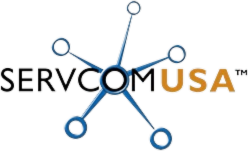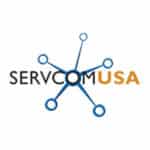Servcom USA Equips Client With The Perfect Remote-Ready IT Environment
The COVID-19 pandemic shed a light on how important it is for organizations and companies to be able to pivot quickly and take advantage of opportunities, during challenging times.
The ability to work remotely was proven to be such an opportunity and allowed organizations to be flexible and responsive.
That’s why clients like this public agency have turned to Servcom USA to have us establish high-performance and secure remote work tools.
Download our Sucess Story here
Remote Work Capabilities Are A Must
If your organization is planning to continue with remote work into the future, you’re not alone in that decision—according to 317 CFOs recently surveyed by Gartner, 74% say they expect to move previously on-site employees remote post-COVID-19.
Furthermore, although it may be safe to bring your staff into the office, it’s important not to forget all the hard lessons learned during this pandemic.
Subsequent waves are a distinct possibility, and so, you need to make sure you have a viable remote work plan in place that can be launched quickly.
The question is: are you remote ready? This is a common concern we’ve heard from clients…
This Client Needed Reliable Remote Capabilities
IT resources have never been as important as they are now as a majority of professionals work from home.
In order for organizations like this one to stay connected and productive while working remotely, they need the right technologies and processes in place.
Due to how quickly the pandemic developed, many organizations were unable to prepare for the shift to a remote work setting.
Doing so would have required careful planning, methodical execution of new processes, and expert implementation of new technologies.
Fortunately for this client, they had been working with Servcom USA for more than a decade when the pandemic hit.
They knew they needed to have a solution that was affordable, scalable, and secure and that enabled an efficient remote workforce, and could trust us to deliver.
How Servcom USA Solved This Client’s Problem
Our team knew the perfect solution for this client’s needs was Microsoft Remote Desktop Services.
This remote configuration gave them access to and control over a given computer from any configured device in any location.
Known in the past as “Terminal Services”, Remote Desktop Services is a “component of Microsoft Windows that allows a user to take control of a remote computer or virtual machine over a network connection.
It gives this company’s users the capability to have the same computing experience whether they are using their in-office work computer or while remote working at home or on the go.
Users have the same access no matter where they are, as they can utilize their work-related applications, access their files and data that are stored on the network, and do everything else they would be able to do in the office.
Our team deployed a new on-premise server for the client that would host all their apps and data, from which their team could access anything they needed via Microsoft Remote Desktop Services.
This ensured they would have a high-performance and secure way to continue working remotely long term.
The Benefits (And Risks) Of Remote Work
The remote work model offers a number of benefits that you’ve likely taken notice of over the course of the pandemic.
Remote workers have seen the benefits as well:
- 77% of remote employees say they’re more productive when working from home
- 76% of employees prefer to avoid their office completely when they need to concentrate on a project
- 98% of remote workers want to continue to work remotely (at least some of the time) for the rest of their careers
However, for all the ways remote work is beneficial to both the organization and end-users, it’s not without its challenges.
You’re reading this ebook, which means you’re worried about remote cybersecurity to some extent—and you should be. 36% of organizations have dealt with a security incident due to an unsecured remote worker.
According to Morphisec’s Work-from-Home Employee Cybersecurity Threat Index, 20% of workers said their IT team had not provided any tips as they shifted to working from home.
Is that the case for your remote workers?
Cybersecurity Considerations For Remote Work
When the COVID-19 crisis hit, it hit fast.
Despite what, in retrospect, may have seemed like a gradual build-up, it was virtually over the course of a single weekend in March that businesses across the US had to pivot to a remote work model.
Obviously, the first priority was maintaining business continuity. You needed to make sure your newly remote workers had the technology and the remote access necessary to do their work.
But the process doesn’t end there—security is a complicated undertaking for remote work models, and needs ongoing attention.
Continuing with a remote work model, whether entirely or in part, will require:
- Enhancing security measures
- Providing the right hardware for users working permanently from home
- Implementing more permanent file-sharing and collaboration tools
Critical Remote Security Solutions For Long-Term Remote Work
Even before the pandemic, it was becoming increasingly common for businesses to hire remote workers — that is, staff members that work from home, outside of the business’ city of operation, and even much further away.
It’s important to recognize that when businesses start prioritizing remote access to data over the security of that data, they make an easy target for hackers.
Think of it this way—at the office, everything is protected by the same set of cybersecurity solutions.
You have firewalls, antivirus software, etc. These are defenses that you’ve invested in and can trust.
Is the same true of your employees’ home networks and personal devices? Probably not.
With so many employees operating remotely, working from a laptop or smartphone, how can you be sure that your data is completely secure? Are you taking the necessary steps to maintain security while your staff works from home?
Many owners and managers assume that a VPN is enough to protect their business while managing a remote work environment. That’s not necessarily true…
What Is A Virtual Private Network?
While you may have been using a Virtual Private Network (VPN) for remote access so far, that doesn’t mean there isn’t a superior alternative for you to consider. Servcom USA recommends Remote Desktop Services for all our clients because it offers a greater level of control, and it works seamlessly with an existing VPN.
A VPN creates a secure tunnel for your data to transit the Internet, using a network of private servers.
When you use a VPN, your data is encrypted, or hidden, as it moves from your device to the VPN and then continues onto the Internet through what’s called an exit node. A VPN creates the appearance that your data is coming from the VPN server, not from your device.
Therefore, it’s harder for an attacker to identify you as the source of the data. Even if attackers can intercept your data, the encryption means the attackers can’t understand your data or use it to their advantage.
When you put your data out to the VPN server, it exits back out to the public internet. If the site you’re visiting has HTTPS to keep the connection safe, you are still secure.
Why Does Servcom USA Recommend Remote Desktops?
This solution provides a range of benefits for remote and conventional organizations and businesses alike.
Remote Desktops Are Secure
- When combined with VPN or another remote-access technology, conditional access protocols prevent unknown applications from gaining access without review
- Multi-factor authentication protects access
- Mass updates allow you to keep systems protected
- Remote Desktops can be made compliant with a range of regulations, including ISO 27001, 27018 and 27701, PCI, FedRAMP High for Commercial and HIPAA
- Can be deployed in an on-premise facility, in the cloud, or at a secure, reliable data center
Remote Desktops Are Cost-Effective
- Scale resources precisely, activating only the number of desktops you need for your current users
- Pay only for what you use
- No purchases or upfront costs, and licensing expenses are vastly reduced
Remote Desktops Promote Productivity And Continuity
- Let your staff work from the familiar business computer they’re used to in the office
- Give your staff the freedom to work from their preferred home device
- No physical setup for any new devices is required at any time
Although you may be able to bring your staff fully into the office soon, or have already done so in some capacity, it’s important not to forget all the hard lessons learned during this pandemic so far.
After more than a year of the COVID-19 pandemic, it’s likely that your organization or business has gotten into a rhythm with remote work—but if you’re not satisfied with your current remote access solution, it is best to find the right solution and optimize your processes.
Servcom USA Will Help You Harness The Power Of Remote Desktops
Are Remote Desktops right for your organization?
We can’t answer that question for you—all we know is that if your business is operating remotely right now, you need a way to access work data.
If you don’t have an ideal solution in place, your business may be falling behind.
Using new technologies and managing a team of remote staff members isn’t easy. We want you to know that you don’t have to do it alone—our team is here to help.
If you’re interested in trying out Remote Desktops for your organization, get in touch with our team to discover more about how they work and what they have to offer your organization.
Looking For An IT Team With Remote Capability Expertise?
One thing to keep in mind is that well-managed service providers are being nabbed up fast.
Organizations across the US are quickly realizing that they need reliable IT service and enhanced support for the new systems and subsequent risks that have been presented during this time of COVID-19.
If you’re looking for help with your remote work, contact Servcom USA.


